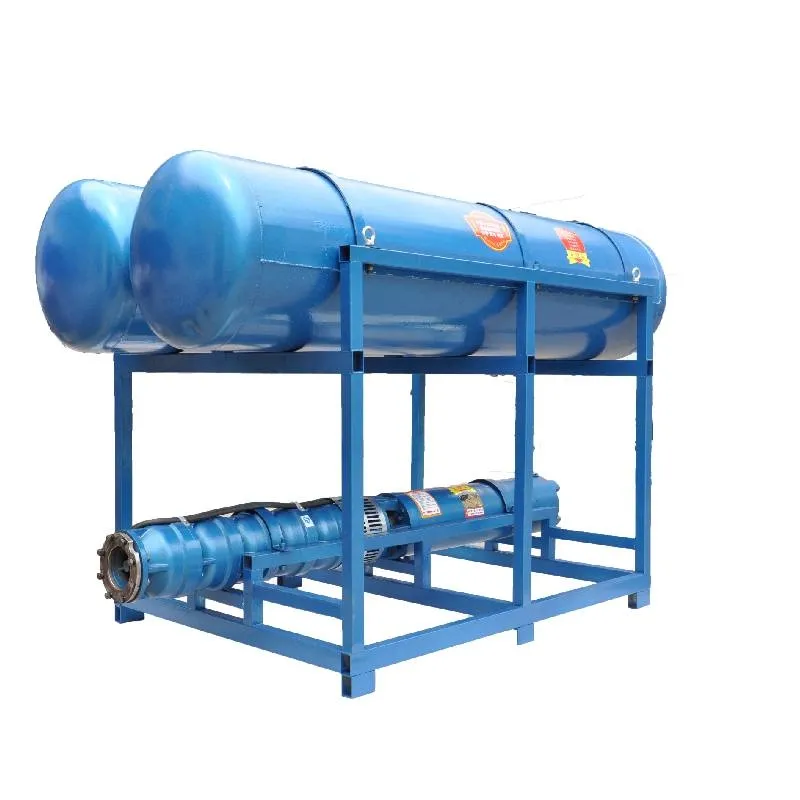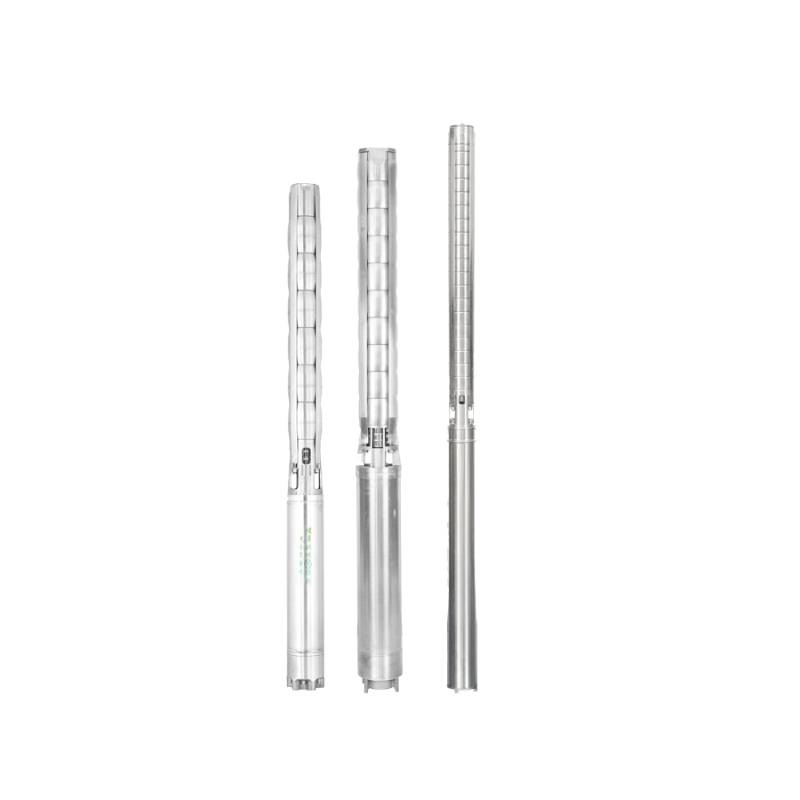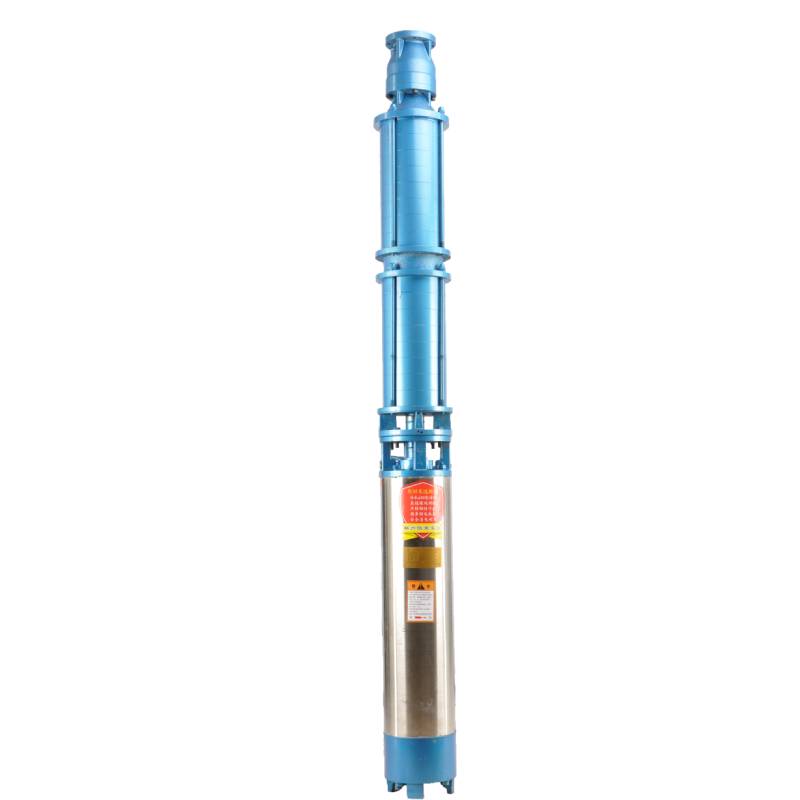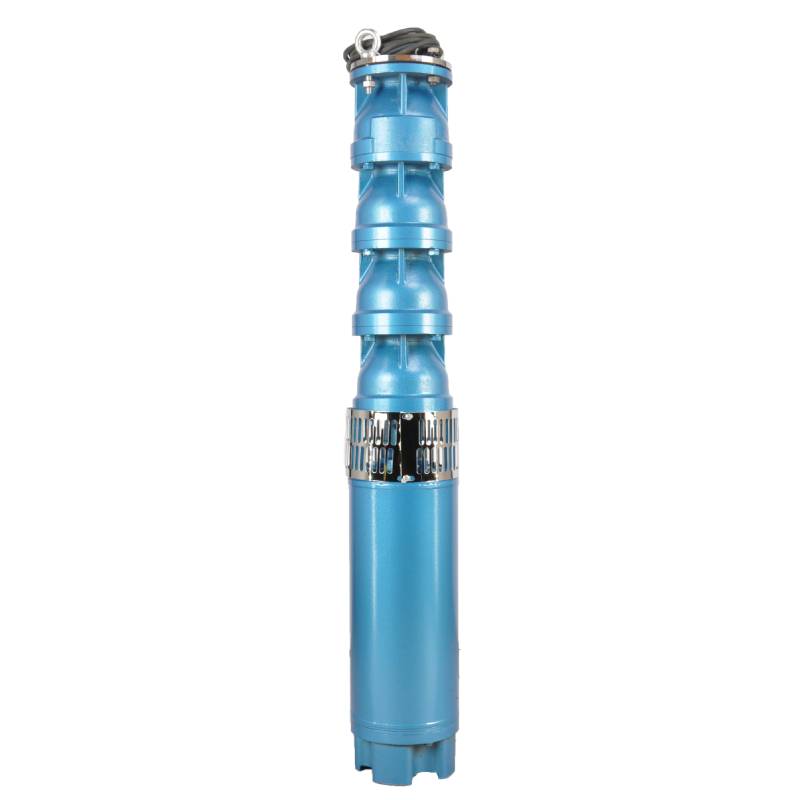Frequency conversion winding design, ensure the motor in 1HZ-50HZ long-term stable conversion operation. Energy saving, longer service life.
1, alimentation : triphasé AC 380 V (tolérance +/- 5 %), 50 Hz (tolérance +/- 1 %).
2, qualité de l'eau :
(1) water temperature is not higher than 20 °C;
(2) la teneur en impuretés solides (rapport massique) n’est pas supérieure à 0,01 % ;
(3) valeur du pH (pH) 6,5-8,5 ;
(4) la teneur en sulfure d'hydrogène ne dépasse pas 1,5 mg/L ;
(5) la teneur en ions chlorure ne dépasse pas 400 mg/L.
3, le moteur est une structure humide fermée ou remplie d'eau, avant utilisation, la cavité du moteur submersible doit être pleine d'eau propre, pour éviter un faux plein, puis serrer l'injection d'eau, les boulons de libération d'air, sinon l'utilisation n'est pas autorisée
4, la pompe submersible doit être complètement immergée dans l'eau, la profondeur de plongée ne dépasse pas 70 m, le fond de la pompe submersible depuis le fond du puits n'est pas inférieur à 3 m.
5, le débit d'eau du puits doit être capable de répondre à la sortie d'eau de la pompe submersible et à un fonctionnement continu, la sortie d'eau de la pompe submersible doit être contrôlée à 0,7 à 1,2 fois le débit nominal.
6, le puits doit être droit, la pompe submersible ne peut pas être utilisée ou vidée, uniquement une utilisation verticale.
7, la pompe submersible doit être adaptée au câble selon les exigences et au dispositif externe de protection contre les surcharges. 8, la pompe est strictement interdite sans machine de test à vide d'eau
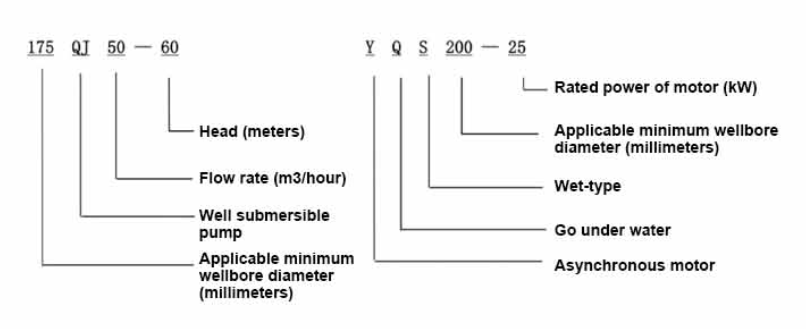
| Modèle | Débit (m3/h) | Tête (m) |
Rotating speed(change/point) | Pompe à eau(%) | Sortie diamètre (mm) |
Bien applicable diamètre (mm) |
Noté puissance (KW) |
Rated voltage(V) | Ratedcurrent(A) | Efficacité moteur (%) | power factorcosφ | Unité Taille maximale radiale (mm) |
Remarque | |||||||||
| 125QJ5-34 | 5 | 34 | 2850 | 53 | 40 | 125au-dessus de | 1.5 | 380 | 4.23 | 70.0 | 0.77 | 118 | ||||||||||
| 125QJ5-51 | 51 | 2.2 | 6.03 | 72.0 | 0.77 | |||||||||||||||||
| 125QJ5-68 | 68 | 3 | 8.01 | 73.0 | 0.78 | |||||||||||||||||
| 125QJ5-85 | 85 | 4 | 10.53 | 74.0 | 0.78 | |||||||||||||||||
| 125QJ5-102 | 102 | 5.5 | 14.1 | 75.0 | 0.79 | |||||||||||||||||
| 125QJ5-119 | 119 | 5.5 | 14.1 | 75.0 | 0.79 | |||||||||||||||||
| 125QJ10-24 | 10 | 24 | 2850 | 60 | 50 | 125au-dessus de | 1.5 | 380 | 4.23 | 70.0 | 0.77 | 118 | ||||||||||
| 125QJ10-32 | 32 | 2.2 | 6.03 | 72.0 | 0.77 | |||||||||||||||||
| 125QJ10-48 | 48 | 3 | 8.01 | 73.0 | 0.78 | |||||||||||||||||
| 125QJ10-56 | 56 | 4 | 10.53 | 74.0 | 0.78 | |||||||||||||||||
| 125QJ10-72 | 72 | 5.5 | 14.1 | 75.0 | 0.79 | |||||||||||||||||
| 125QJ10-80 | 80 | 5.5 | 14.1 | 75.0 | 0.79 | |||||||||||||||||
| 125QJ10-104 | 104 | 7.5 | 19.0 | 76.0 | 0.79 | |||||||||||||||||
| 125QJ10-120 | 10 | 120 | 2850 | 60 | 50 | 125au-dessus de | 7.5 | 380 | 19.0 | 76.0 | 0.79 | 118 | ||||||||||
| 125QJ10-136 | 136 | 9.2 | 22.7 | 77.0 | 0.8 | |||||||||||||||||
| 125QJ15-36 | 15 | 36 | 2850 | 63 | 50 | 125au-dessus de | 2.2 | 380 | 6.03 | 72.0 | 0.77 | 118 | ||||||||||
| 125QJ15-39 | 39 | 3 | 8.01 | 73.0 | 0.78 | |||||||||||||||||
| 125QJ15-46 | 46 | 4 | 10.53 | 74.0 | 0.78 | |||||||||||||||||
| 125QJ15-52 | 52 | 4 | 10.53 | 74.0 | 0.78 | |||||||||||||||||
| 125QJ15-59 | 59 | 5.5 | 14.1 | 75.0 | 0.79 | |||||||||||||||||
| 125QJ15-65 | 65 | 5.5 | 14.1 | 75.0 | 0.79 | |||||||||||||||||
| 125QJ15-78 | 78 | 7.5 | 19.0 | 76.0 | 0.79 | |||||||||||||||||
| 125QJ15-91 | 91 | 7.5 | 19.0 | 76.0 | 0.79 | |||||||||||||||||
| 125QJ15-104 | 104 | 9.2 | 22.7 | 77.0 | 0.8 | |||||||||||||||||
| 125QJ20-16 | 20 | 16 | 2850 | 64 | 50 | 125au-dessus de | 2.2 | 380 | 6.03 | 72.0 | 0.77 | 118 | ||||||||||
| 125QJ20-24 | 24 | 3 | 8.01 | 73.0 | 0.78 | |||||||||||||||||
| 125QJ20-32 | 32 | 4 | 10.53 | 74.0 | 0.78 | |||||||||||||||||
| 125QJ20-40 | 40 | 4 | 10.53 | 74.0 | 0.78 | |||||||||||||||||
| 125QJ20-48 | 48 | 5.5 | 14.1 | 75.0 | 0.79 | |||||||||||||||||
| 125QJ20-56 | 56 | 5.5 | 14.1 | 75.0 | 0.79 | |||||||||||||||||
| 125QJ20-64 | 64 | 7.5 | 19.0 | 76.0 | 0.79 | |||||||||||||||||
| 125QJ20-72 | 72 | 7.5 | 19.0 | 76.0 | 0.79 | |||||||||||||||||
| 125QJ20-80 | 80 | 9.2 | 22.7 | 77.0 | 0.8 | |||||||||||||||||
| 125QJ25-12 | 25 | 12 | 2850 | 64 | 65 | 125au-dessus de | 2.2 | 380 | 6.03 | 72.0 | 0.77 | 118 | ||||||||||
| 125QJ25-18 | 18 | 3 | 8.01 | 73.0 | 0.78 | |||||||||||||||||
| 125QJ25-24 | 24 | 4 | 10.53 | 74.0 | 0.78 | |||||||||||||||||
| 125QJ25-30 | 30 | 4 | 10.53 | 74.0 | 0.78 | |||||||||||||||||
| 125QJ25-36 | 36 | 5.5 | 14.1 | 75.0 | 0.79 | |||||||||||||||||
| 125QJ25-48 | 48 | 7.5 | 19.0 | 76.0 | 0.79 | |||||||||||||||||
| 125QJ25-60 | 60 | 9.2 | 22.7 | 77.0 | 0.8 | |||||||||||||||||
| 125QJ32-24 | 32 | 24 | 2850 | 64 | 80 | 125au-dessus de | 4 | 380 | 10.53 | 74.0 | 0.78 | 118 | ||||||||||
| 125QJ32-30 | 30 | 5.5 | 14.1 | 75.0 | 0.79 | |||||||||||||||||
| 125QJ32-42 | 42 | 7.5 | 19.0 | 76.0 | 0.79 | |||||||||||||||||
| 125QJ32-54 | 54 | 9.2 | 22.7 | 77.0 | 0.8 | |||||||||||||||||
| 125QJ5-240 | 5 | 240 | 2850 | 40 | 125au-dessus de | 11 | 380 | 26.28 | 118 | |||||||||||||
| 125QJ5-280 | 280 | 13 | 30.87 | |||||||||||||||||||
| 125QJ5-320 | 320 | 15 | 35.62 | |||||||||||||||||||
| 125QJ10-180 | 10 | 180 | 2850 | 50 | 125au-dessus de | 11 | 380 | 26.28 | 118 | |||||||||||||
| 125QJ10-210 | 210 | 13 | 30.87 | |||||||||||||||||||
| 125QJ10-240 | 240 | 15 | 35.62 | |||||||||||||||||||
| 125QJ15-120 | 15 | 120 | 2850 | 50 | 125au-dessus de | 11 | 380 | 26.28 | 118 | |||||||||||||
| 125QJ15-142 | 142 | 13 | 30.87 | |||||||||||||||||||
| 125QJ15-162 | 162 | 15 | 35.62 | |||||||||||||||||||
| 125QJ20-100 | 20 | 100 | 2850 | 50 | 125au-dessus de | 11 | 380 | 26.28 | 118 | |||||||||||||
| 125QJ20-120 | 120 | 13 | 30.87 | |||||||||||||||||||
| 125QJ20-136 | 136 | 15 | 35.62 | |||||||||||||||||||
| 125QJ25-82 | 25 | 82 | 2850 | 65 | 125au-dessus de | 11 | 380 | 26.28 | 118 | |||||||||||||
| 125QJ25-97 | 97 | 13 | 30.87 | |||||||||||||||||||
| 125QJ25-110 | 110 | 15 | 35.62 | |||||||||||||||||||
| 125QJ32-68 | 32 | 68 | 2850 | 80 | 125au-dessus de | 11 | 380 | 26.28 | 118 | |||||||||||||
| 125QJ32-80 | 80 | 13 | 30.87 | |||||||||||||||||||
| 125QJ32-92 | 92 | 15 | 35.62 | |||||||||||||||||||
| 125QJ40-46 | 40 | 46 | 2850 | 80 | 125au-dessus de | 11 | 380 | 26.28 | 118 | |||||||||||||
| 125QJ40-54 | 54 | 13 | 30.87 | |||||||||||||||||||
| 125QJ40-62 | 62 | 15 | 35.62 | |||||||||||||||||||
The well submersible pump is a pump suitable for clear water. It is strictly prohibited to dig new wells and pump out mud and sand. The voltage grade of the well pump is 380V/50HZ, and other voltage grades of the submersible motor need to be customized. Underground cables must be waterproof cables and must be equipped with starting equipment, such as distribution box, etc. The starting equipment should have common motor comprehensive protection functions, such as short circuit overload protection, phase loss protection, undervoltage protection, grounding protection and idling protection, etc. In abnormal cases, the protective device should be tripped in time. When installing and using the pump, it must be firmly grounded. It is prohibited to push and pull the switch when the hands and feet are wet. The power supply must be cut off before installing and maintaining the pump. An obvious "anti-electric shock" sign must be set up where the pump is used. Before going down the well or installing the motor, the inner cavity must be filled with distilled water or non-corrosive clean cold water, and the water injection/drainage bolts must be tightened. Fill the pump with water for ground test to lubricate the rubber bearings. The instant start time shall not exceed one second to check whether the direction is correct and consistent with the direction indication. Be sure to pay attention to safety when placing the pump upright to prevent overturning and causing injury. Strictly in accordance with the provisions of the pump lift and flow range of use, to prevent the pump flow at low lift or excessive pull at high lift, resulting in extreme wear of thrust bearings and other components, resulting in motor overload burn. After the pump into the well, the insulation resistance between the motor and the ground shall be measured, which shall not be less than 100MΩ. After the start, observe the voltage and current regularly, and check the motor winding insulation, to see if it meets the requirements; if the pump storage temperature is below the freezing point, the water in the motor cavity should be discharged, so as to avoid the water in the motor cavity freezing and damaging the motor due to low temperature.
Les principales caractéristiques du produit comprennent :
1.The motor is a water-loaded wet submersible three-phase asynchronous motor,and the motor cavity is filled with clean water for cooling the motor and lubricating the bearing.The regulating diaphragm at the bottom of the motor is used to adjust the expansion and contraction pressure difference inside and outside the body caused by the temperature rise of the motor.
2.In order to prevent the sand particles in the well water from entering the motor,two oil seals are installed at the extension end of the motor shaft,and the sand ring is installed to form a sand prevention structure.
3.In order to prevent the pump shaft from jumping when starting,the pump shaft is connected with the motor shaft through a coupling,and the thrust bearing is installed at the bottom of the motor.
4.The lubrication of the motor and the pump bearing is water lubrication.
5.The stator winding of the motor adopts high-quality submersible motor winding wire,with excellent insulation performance.
6.The pump is designed by computer CAD,with simple structure and excellent technical performance.

(1)Préparation avant installation :
1. Vérifiez si la pompe submersible répond aux conditions d'utilisation et à la portée spécifiées dans le manuel.
2. À l'aide d'un objet lourd d'un diamètre égal au diamètre extérieur maximum de la pompe submersible, mesurez si le diamètre intérieur du puits de forage peut s'adapter à la pompe submersible et mesurez si la profondeur du puits répond aux exigences d'installation.
3. Vérifiez si le puits de forage est propre et si l'eau du puits est trouble. N'utilisez jamais de pompe électrique submersible pour laver la boue et l'eau de sable de la pompe welor afin d'éviter des dommages prématurés à la pompe électrique submersible.
4. Vérifiez si la position de la pince d'installation de la tête de soudure est appropriée et si elle peut résister à la qualité de l'ensemble de l'unité.
5. Vérifiez si les composants de la pompe submersible sont complets et installés correctement selon le schéma d'assemblage dans le manuel. Retirez le tamis filtrant et faites tourner l'accouplement pour voir s'il tourne de manière flexible.
6. Dévissez la vis à eau et remplissez la cavité du moteur avec de l'eau propre et non corrosive (remarque : assurez-vous de la remplir), puis serrez la vis à eau. Après 12 heures d'injection d'eau, la résistance d'isolation du moteur ne doit pas être inférieure à 150 M Q lorsqu'elle est mesurée avec une table vibrante de 500 V.
7. Cable joint, cut off a 120mm rubber sleeve from one end of the outgoing cable and the matching cable with an electrician's knifethen stagger the length of the three core wires in a stepped shape, peel off a 20mm copper core, scrape of the oxide layer on theoutside of the copper wire with a knife or sand cloth, and insert the two connected wire ends in palirs.
After tying the layer tightly with fine copper wire, solder it thoroughly and firmly, and sand of any. burrs on the surface. Then, forthe three joints, use polyvester insulation tape to wrap them in a semi stacked manner for three lavers. Wrap the two ends of thewrapping layer tightywith nyion thread,and then use a semi stacked method to wrap the tape for three layers. Wrap the outellayer with high-pressure insulation tape for three layers. Finally, fold the threestrands together and repeatedly wrap them for fivelayers with high-pressure tape. Each layer must be tightly tied, and the interlayer joints must be tight and fimm to prevent water frompenetrating and damaging the insulation, After wrapping, soak in water at room temperature of 20 ’c for 12 hours, and measurethe insulation resistance with a shaking table, which should not be less than 100M Ω
Le schéma du processus de câblage des câbles ci-joint est le suivant :
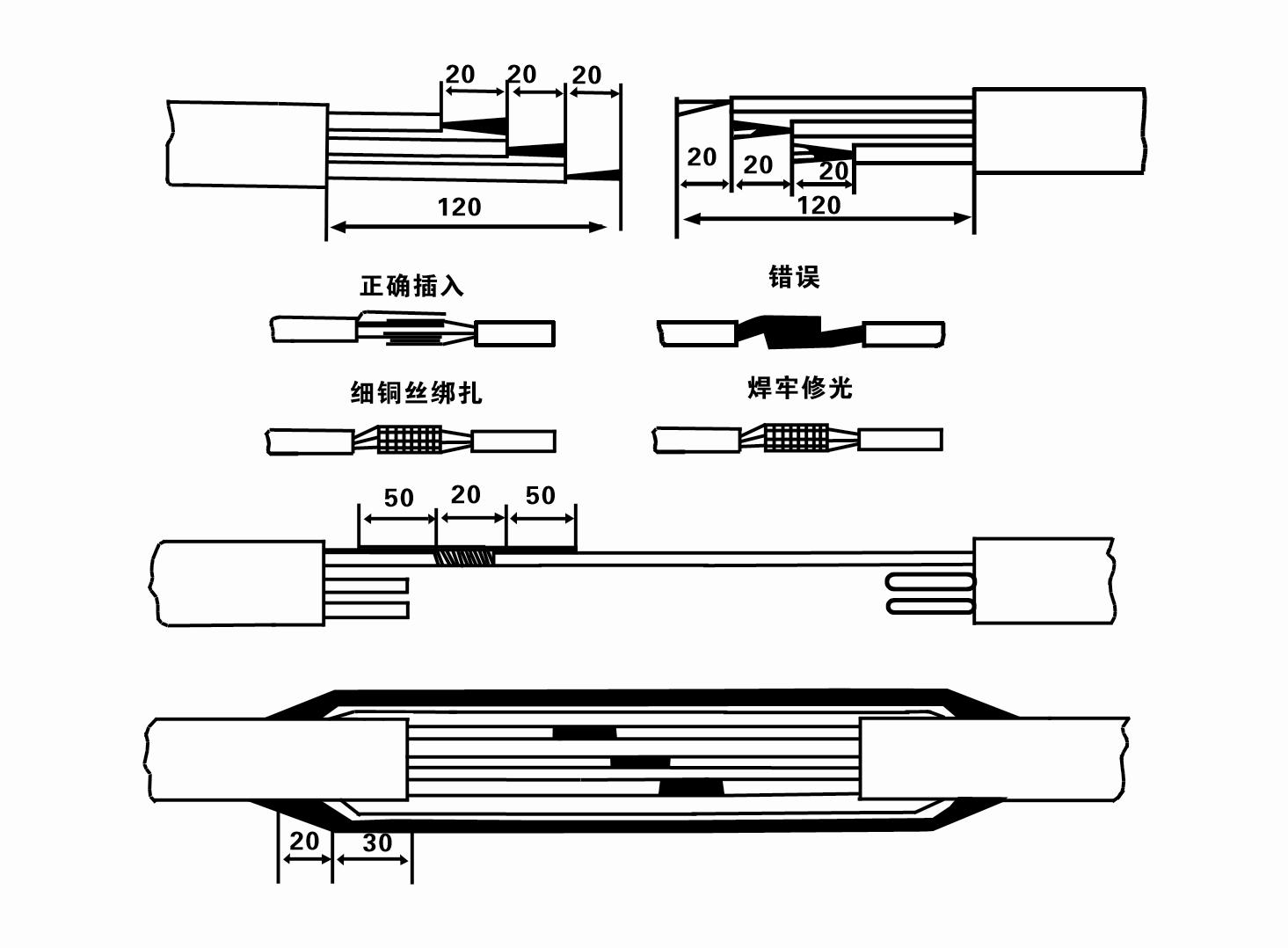
8. Utilisez un multimètre pour vérifier si les fils triphasés sont connectés et si la résistance CC est approximativement équilibrée.
9. Check whether the circuit and transformer capacity are overloaded, and then connect the overload protection switch or starting equipment. See Table 2 for specific models, and then
Pour a bucket of water into the water pump from the water pump outlet to lubricate the rubber bearings in the pump, and then place the submersible electric pump upright and steady.
Start (no more than one second) and check whether the steering direction is consistent with the steering sign. If not, swap any two connectors of the three-phase cable.
Then install the filter and prepare to go down the well. If used in special occasions (such as ditches, ditches, rivers, ponds, ponds, etc.), the electric pump must be reliably grounded.
(2)Équipement et outils d'installation :
1. Une paire de chaînes de levage pour plus de deux tonnes.
2. Un trépied d'une hauteur verticale d'au moins quatre mètres.
3. Deux cordes suspendues (câbles métalliques) pouvant supporter un poids de plus d'une tonne (peuvent supporter le poids d'un ensemble complet de pompes à eau).
4. Installez deux paires de pinces (attelles).
5. Clés, marteaux, tournevis, outils et instruments électriques, etc.
(3)Installation de pompe électrique :
1. Le schéma d'installation de l'électropompe submersible est illustré à la figure 2. Les dimensions d'installation spécifiques sont indiquées dans le tableau 3 « Liste des dimensions d'installation de l'électropompe submersible ».
2. Les pompes électriques submersibles d'une hauteur inférieure à 30 mètres peuvent être hissées directement dans le puits à l'aide de tuyaux et de câbles métalliques ou d'autres câbles de chanvre pouvant supporter tout le poids de la machine entière, des conduites d'eau et de l'eau dans les conduites.
3. Les pompes d'une hauteur de plus de 30 mètres utilisent des tuyaux en acier et la séquence d'installation est la suivante :
①Use a clamp to clamp the upper end of the water pump part (the motor and water pump have been connected at this time), lift it with a hanging chain, and slowly tie it into the well until
Put the clamp on the wellhead and remove the hanging chain.
② Use another pair of clamps to clamp a pipe, lift it with a hanging chain 15 cm away from the flange, and lower it slowly. Between pipe flange and pump flange
Put the rubber pad in place and tighten the pipe and pump evenly with bolts, nuts and spring washers.
③ Soulevez légèrement la pompe submersible, retirez la pince à l'extrémité supérieure de la pompe à eau, attachez fermement le câble à la conduite d'eau avec un ruban en plastique et attachez-le lentement jusqu'à ce que la pince soit placée à la tête de puits.
④Utilisez la même méthode pour relier toutes les conduites d’eau au puits.
⑤ Une fois le câble de sortie connecté à l'interrupteur de commande, il est connecté à l'alimentation triphasée.
(4) Choses à noter lors de l’installation :
1. If a jamming phenomenon is found during the pumping process, turn or pull the water pipe to overcome the jamming point. If various measures still do not work, please
Do not force the pump down to avoid damage to the submersible electric pump and the well.
2. Lors de l'installation, un tampon en caoutchouc doit être placé sur la bride de chaque tuyau et serré uniformément.
3. Lorsque la pompe à eau est abaissée dans le puits, elle doit être placée au milieu du tuyau du puits pour empêcher la pompe de fonctionner contre la paroi du puits pendant une longue période, provoquant ainsi la vibration de la pompe et le balayage et la combustion du moteur. .
4. Déterminez la profondeur de la pompe à eau jusqu'au fond du puits en fonction des conditions d'écoulement du sable et du limon du puits. N'enfouissez pas la pompe dans la boue. La distance entre la pompe à eau et le fond du puits n'est généralement pas inférieure à 3 mètres (voir Figure 2).
5. La profondeur d'entrée de l'eau de la pompe à eau ne doit pas être inférieure à 1 à 1,5 mètres entre le niveau d'eau dynamique et le nœud d'entrée d'eau (voir Figure 2). Sinon, les roulements de la pompe à eau pourraient être facilement endommagés.
6. La levée de la pompe à eau ne peut pas être trop faible. Sinon, un robinet-vanne doit être installé sur la canalisation d'eau de la tête de puits pour contrôler le débit de la pompe au point de débit nominal afin d'éviter que le moteur ne soit surchargé et grillé en raison de débits élevés.
7. Lorsque la pompe à eau fonctionne, le débit d'eau doit être continu et uniforme, le courant doit être stable (dans les conditions de travail nominales, généralement pas plus de 10 % du courant nominal) et il ne doit y avoir aucune vibration ni bruit. En cas d'anomalie, la machine doit être arrêtée pour en rechercher la cause et l'éliminer.
8. Lors de l'installation, faites attention au réglage du fil de terre du moteur (voir Figure 2). Lorsque la conduite d'eau est un tuyau en acier, faites-la sortir du collier de serrage de la tête de puits ; lorsque le tuyau d'eau est un tuyau en plastique, faites-le passer du repère de mise à la terre de la pompe électrique.
- 1. Une fois la pompe submersible installée, vérifiez à nouveau la résistance d'isolation et la conduction triphasée de l'interrupteur, vérifiez si l'instrument et la connexion de l'équipement de démarrage sont incorrects, s'il n'y a pas de problème, la machine d'essai peut être démarrée, et observez si les lectures de l'indicateur de l'instrument dépassent la tension et le courant nominal spécifiés sur la plaque signalétique après le démarrage, et observez si la pompe présente un phénomène de bruit et de vibration, et mettez-la en service si tout est normal.
- 2. Après le premier fonctionnement de la pompe pendant quatre heures, le moteur doit être arrêté pour tester rapidement la résistance de l'isolation thermique, et sa valeur ne doit pas être inférieure à 0,5 mégaohm.
- 3. Une fois la pompe arrêtée, elle doit être démarrée après cinq minutes pour éviter que la colonne d'eau dans le tuyau ne reflue complètement et ne provoque un courant excessif du moteur et un épuisement.
- 4. Une fois la pompe mise en fonctionnement normal, afin de prolonger sa durée de vie, il est nécessaire de vérifier régulièrement si la tension d'alimentation, le courant de fonctionnement et la résistance d'isolation sont normaux. Si les conditions suivantes sont rencontrées, la pompe doit être arrêtée immédiatement pour dépanner.
- 1 In the rated condition, the current exceeds 20%.
- 2 Le niveau d'eau dynamique descend jusqu'à la section d'entrée d'eau, provoquant une eau intermittente.
- 3 La pompe submersible présente des vibrations ou du bruit importants.
- 4 La tension d'alimentation est inférieure à 340 volts.
- 5 Un fusible est grillé.
- 6 Le tuyau d'alimentation en eau est endommagé.
- 7 The motor's thermal insulation resistance is lower than 0.5 megaohm.
- Unit disassembly:
- 1.Untie the cable tie, remove the pipeline part, and remove the wire plate.
- 2.screw down the water bolt, put the water in the motor chamber.
- 3.remove the filter, loose the fixed screw on the coupling to fix the motor shaft.
- 4.screw down the bolt connecting the water inlet section with the motor, and separate the pump from the motor (pay attention to the unit cushion when separating, to prevent the bending of the pump shaft)
- 5.the disassembly sequence of the pump is: (see figure 1) water inlet section, impeller, diversion shell, impeller...... check valve body, when removing the impeller, use special tools to loosen the conical sleeve of the fixed impeller first, and avoid bending and bruising the pump shaft in the process of disassembly.
- 6.the disassembly process of the motor is: (see figure 1) place the motor on the platform, and remove the nuts, base, shaft head locking nut, thrust plate, key, lower guide bearing seat and double head bolt from the bottom of the motor in turn, and then take out the rotor (pay attention not to damage the wire package) and finally remove the connecting section and upper guide bearing seat.
- 7.unit assembly: before assembly, the rust and dirt of the parts should be cleaned, and the mating surface and fasteners coated with sealant, and then assembled in the opposite order of disassembly (the motor shaft moves up and down after assembly for about one millimeter), after assembly, the coupling should be flexible, and then the filter screen test machine. Submersible pumps shall be taken out of the well for dismantling and maintenance according to Article 5 after a year of operation, or less than a year of operation but two years of diving time, and the worn parts shall be replaced.
This product is an efficient and durable submersible electric pump, suitable for a variety of environments and applications.In order to ensure the long-term use and stable performance of the product, we suggest that users pay special attention to drying the water in the motor cavity in winter to avoid freezing; in addition, the cable is coiled and tied, and properly stored in an environment without corrosive substances and gases, with a temperature below 40 °C. If the product is not used for a long time, attention should be paid to rust prevention treatment to ensure the life cycle and performance of the product.Whether for industrial use or for home use, this submersible electric pump can provide you with reliable pump service.
-
- Turbine
- Manchon d'arbre
- Manchon d'arbre en caoutchouc
-
Bague d'étanchéité
01 Prise d'eau de puits profond
02 Approvisionnement en eau en hauteur
03 approvisionnement en eau de montagne
04 tour d'eau
05 Irrigation agricole
06 arrosage du jardin
07 prise d'eau de rivière
08 eau domestique




